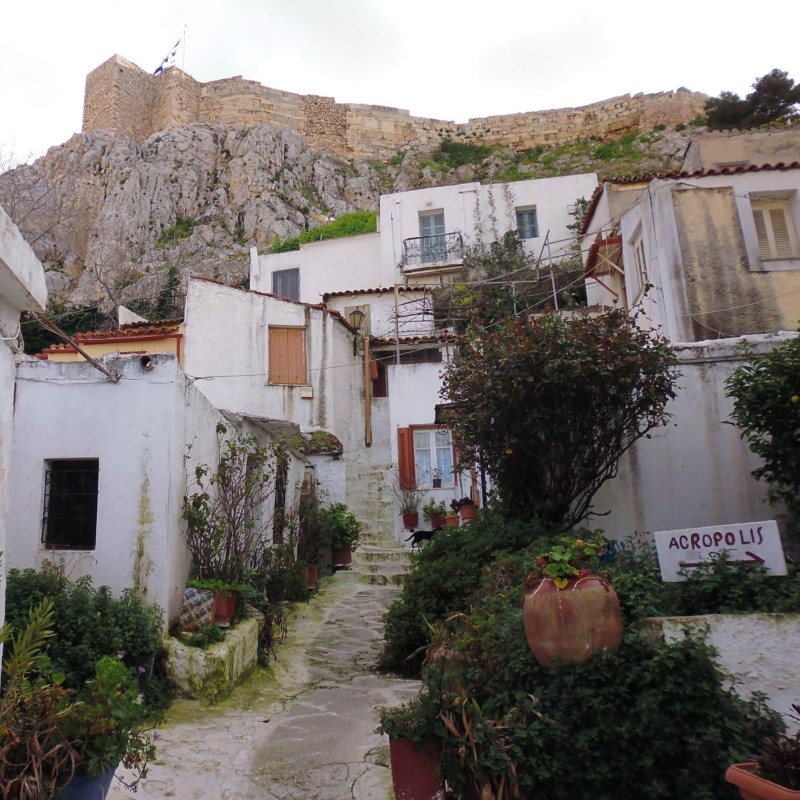
Athens is well known for the famous Acropolis and Parthenon, as well as other ancient sites. But dig deeper and you’ll find there’s a lot more to the city than initially meets the eye. During my time living here, I feel honored to have been able to explore this city in more detail, so here I take you on an introduction to some of the more hidden and less frequented parts of the city, to whet your appetite to explore Athens more after you’ve visited the Acropolis.
Videos by TravelAwaits
1. The Rock Of Areopagus
This is a good place to come after you’ve been into the Acropolis and Parthenon; on your way down from these spots.
The Rock of Areopagus — also known as the Hill of Ares — is situated below the entrance to the Parthenon and distinguishable from the stairs carved out of the marble rocks to reach it. They do get slippery so, beside these, metal steps with a handrail have been installed.
It’s reputed to be the site where Ares — God of War — was tried for the murder of one of Poseidon’s sons. The appeal is that you can sit here with a fantastic 360-degree view of the city: the Acropolis behind you and as far as the port of Piraeus and nearby islands in front.
Many young Athenians come here and spread a blanket out to sit and watch the sunset. Come and join them in this romantic and atmospheric part of the city.
Pro Tip: Wear non-slip trainers/shoes with sturdy soles.
2. The Agora Of Athens
In the gardens at the base of the Acropolis is a little visited monument, but one that really shouldn’t be missed: the Agora.
It’s here that in ancient times, people would visit to have their two pence worth and speak their mind — influencing the modern day Speaker’s Corner in cities such as London or the north side of the White House on Pennsylvania Avenue in Washington, D.C.
It’s said the Agora is where Socrates was tried for corrupting the minds of young people. He was found guilty and ordered to drink hemlock as his death punishment.
It’s an interesting place to rest up after climbing the Acropolis rock, knowing you’re in the midst of where modern democracy originated.

3. Hidden Island Village Of Anafiotika
Have you ever heard of an island within a city? In Athens, it’s a reality. Beneath the Acropolis monument, hidden in the cobbled alleyways of Plaka you’ll find the unique neighborhood of Anafiotika, consisting of cute bougainvillea-clad sugar cube island-type homes.
It came about in 1832 when the first King of Greece — King Otto of Bavaria — drafted in workers from the Greek Island of Anafi to build his Presidential Palace. Homesick as they were, the workers built themselves houses at the base of the Acropolis monument that resembled those found on their island, creating their own neighborhood with an island feel.
Today, there are 45 houses remaining each with its own unique feeling of peace, solitude, and fantastic city views.
From the Plaka Stairs, keep walking upwards towards the Acropolis and ask locals along the way, you’ll be pointed in the right direction.

4. Hourly Changing Of The Guard
Nearest Metro: Syntagma
You’ve seen the Acropolis and the surrounding area, now let’s move on to the Parliament Square of Syntagma, where you’ll find the Evzones — Greek Presidential Guards — changing guard every hour.
Evzones are traditional guards and wear the uniform of the Klephts — mountain fighters who fought the Turks from the 15–19th century. They wear white tights, the Foustanella skirt with 400 pleats to represent each year of Ottoman occupation. They also wear a white Ypodetes blouse with full sleeves that flare when marching, the Fermeli hand-embroidered wool vest, red cap, the Tsarouchi (stiff hand-sewn leather shoes with upturned toe), large woolen pompom, and 60 nails on the base of each shoe that simulates the sound of battle as they march.
Evzones stand guard at the Tomb of the Unknown Soldier in front of the Parliament building and raise and lower the Greek flag at the Acropolis every Sunday.
Also on a Sunday, at 11 a.m., tourists and Athenians line the streets near Parliament to see the Grand Change, a ceremonious march from their barracks to the Tomb of the Unknown Soldier along with a marching band.
They undertake many months of training and it’s an extreme honor to be chosen to be an Evzone, to represent their country in this manner.
To witness the Evzones in action and their intense concentration as they remain perfectly still for an hour before performing a ceremonial dance is a unique experience to be had when visiting Athens.

5. National Gardens
Nearest Metro: Syntagma
A few meters away from the main Parliament Building of Syntagma, in the midst of the hustle and bustle of the city, you’ll find a peaceful, green respite of 38 acres of parkland.
The National Gardens was commissioned by Queen Amalia in 1840 and opened to the public in 1920. It’s said the Queen personally spent over 3 hours a day tending to it, and it’s still enjoyed today by Athenians and travelers alike. You’ll find over 7,000 trees, 40,000 bushes and a total of 519 different species of plant life to explore.
Aside from such variety, enjoy wandering among the lakes — six of them — a small Childrens Zoo and Children’s Library with over 6,000 books, two reading rooms, and a fairy tale theme.
You’ll also find the famous Zappeion Megaron building here — an architectural marvel of a building — with eight columns at its entrance and an oval-shaped, open internal area flanked by a two-story colonnade. It’s now used as an exhibition hall.
With two cafe’s to choose from to rest with a ubiquitous Greek frappe after your stroll, the National Gardens is the perfect “country getaway” within the city.
6. Japanese Gardens
A new addition to the Athens landscape, near the equally new National Gallery and Byzantine & Christian Museum in Central Athens you’ll find a 3,500-square-meter (so nearly an acre) garden gifted by the Japanese Embassy to the city of Athens in efforts to support the municipality’s Adopt Your City program.
Walk along pathways and amongst vegetation and water and embrace the principles of Japanese culture for a balance between earth, fire, and water. You’ll find Mediterranean and Japanese plants and shrubs such as maples, cherry blossoms, bamboo, and myrtle as well as granite seats to rest up.
A symbiosis of two cultures, the Japanese Garden in the midst of a chaotic city makes a generous respite.
7. Keramikos Cemetery
Nearest Metro: Evangelismos
About a half-hour pleasant walk from the Acropolis brings you to the ancient cemetery of Kerameikos. Built in the 4th century BC, it depicts how the ancient Greeks regarded death. For example, tombs with statues of pitchers symbolize unwed men were buried there, whereas large tombs were reserved for the wealthier Athenians.
Look out for the statues of a frightening bull, a horseman, sirens, and various human figures; plus ancient jugs, perfume bottles, plates, and urns that have been excavated.

8. Walking In Mount Ymittos
Nearest Metro: Acropolis
We now come to one of my favorite activities. Athens is surrounded by three mountains: Penteli, Parnitha, and the nearest one to the city, Ymittos.
A 10-minute drive from the city center will take you to this gorgeous spot with a plethora of walks and hikes amongst nature. Hidden in the depths of this pine-clad, small mountain range are some beautiful remains of ancient monasteries such as the Monastery of Kaisariani — built during Byzantine times and dating back to the late 11th century. It’s an incredibly peaceful place to visit, and so near the city center.

If you prefer to have a guided experience to also learn a little about the mountain’s history, Nefeli Nine Retreats is more than happy to assist, and very knowledgeable.
It’s a 10-minute drive or taxi ride from the city center to the first fire lookout point which is the starting point for walking.

9. Mount Parnitha And The Abandoned Royal Estate
Onto another favorite of mine — the abandoned Royal Estate of Tatoi found in Mount Parnitha.
This mountain range is 19 miles to the north of Athens and easily accessible by car or taxi.
Nestled within a designated national park of over 10,000 acres of countryside and woodland, you’ll find the abandoned Royal Estate of the original Greek royal family and the birthplace of King George of the Hellenes.

It’s open to the public where you can wander around the countryside and many outhouses and farm buildings such as the winery, stables, and dairy. See from a distance that it’s cordoned off for safety — the Palace itself and outdoor swimming pool, plus the cemetery for the past Kings and Queens of Greece.
A visit to Parnitha and the abandoned Royal Estate makes for an alternative look at the country’s history in beautiful surroundings.
Athens has a plethora of unique and fantastic things to do after you’ve visited the more touristy monuments:
